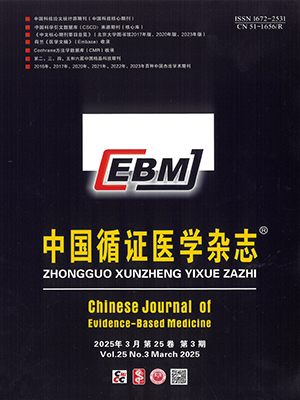Objective To determine the benefits of an invasive compared to a conservative strategy for treating unstable anguba (UA)/ non-ST-elevation myocardial infarction (NSTEMI).
Methods We searched The Cochrane Library (Issue 4, 2009), MEDLINE (1996 to September 2009), EMbase (1974 to September 2009), CBM (1989 to 2009), CNKI (1997 to 2009), and VIP (1989 to 2009). The quality of the included studies was critically evaluated. Data analyses were performed using the Cochrane Collaboration’s RevMan 5.0 software.
Results Seven randomized controlled trials involving 11 394 patients met the inclusion criteria. The results meta-analyses showed the incidence of all-cause mortality at six months follow-up was lower in the early invasive group compared with the conservative group (RR=0.75, 95%CI 0.61 to 0.92, P=0.007); the relative risk of myocardial infarction was significantly decreased in the early invasive group (RR=0.74, 95%CI 0.63 to 0.87); there was a reduction in rehospitalization for unstable angina in the invasive group (RR=0.66, 95%CI 0.61 to 0.73, P lt;0.000 01); the invasive strategy was associated with a two-fold increase in the relative risk of PCI-related myocardial infarction (as variably defined). There was not a significant increase in bleeding by an invasive strategy at six months follow-up, but, a routine invasive strategy was associated with a significantly higher bleeding rate at 1-year follow-up (RR=2.22, 95%CI 1.55 to 3.17, P lt;0.000 1). Patients with elevated cardiac biomarker levels at baseline benefited more from routine intervention, with no significant benefit observed in patients with negative baseline marker levels.
Conclusion An early invasive strategy is preferable to a conservative strategy in the treatment of UA/NSTEMI, especially higher-risk patients with elevated cardiac biomarker benefit more from invasive strategy. In addition, complications such as procedure-MI and bleeding must be paid great attention to.
Citation:
YU Zixiang,MA Yitong,YANG Yining,HUANG Ding,MA Xiang,LI Xiaomei,CHEN You. Benefit of Early Invasive Therapy in Unstable Angina and Non-ST-Elevation Myocardial Infarction: A Systematic Review. Chinese Journal of Evidence-Based Medicine, 2010, 10(11): 1331-1337. doi: 10.7507/1672-2531.20100591
Copy
Copyright © the editorial department of Chinese Journal of Evidence-Based Medicine of West China Medical Publisher. All rights reserved
| 1. |
于子翔, 马依彤. 非ST段抬高急性冠脉综合征介入治疗策略选择. 心血管病学进展, 2009, 30(6): 945-949.
|
| 2. |
Higgins JPT, Green S, editors. Assessing risk of bias in included studies. Cochrane Handbook for Systematic Reviews of Interventions 5.0.0[updated February 2008; Part 2 Chapter 8.In:The Cochrane Library, Issue 3, 2008. Chichester,UK:John Wiley & Sons, Ltd.
|
| 3. |
吴泰相, 刘关键. 隐蔽分组(分配隐藏)和盲法的概念、实施与报告. 中国循证医学杂志, 2007, 7(3): 222-225.
|
| 4. |
Invasive compared with non-invasive treatment in unstable coronary-artery disease: FRISC II prospective randomised multicentre study. FRagmin and Fast Revascularisation during InStability in Coronary artery disease Investigators. Lancet, 1999, 354(9180): 708-715.
|
| 5. |
Cannon CP, Weintraub WS, Demopoulas LA, et al. Comparison of early invasive and conservative strategies in patients with unstable angina and non–ST-segment elevation myocardial infarction treated with the glycoprotein IIb/IIIa inhibitor tirofiban. N Engl J Med, 2001, 344(25): 1879-1887.
|
| 6. |
Spacek R, Widimský P, Straka Z, et al. Value of first day angiography/angioplasty in evolving Non-ST segment elevation myocardial infarction: an open multicenter randomized trial. The VINO Study. Eur Heart J, 2002, 23(3): 230-238.
|
| 7. |
Fox KA, Poole-Wilson PA, Henderson RA, et al. Interventional versus conservative treatment for patients with unstable angina or non-ST-elevation myocardial infarction: the British Heart Foundation RITA 3 randomised trial. Randomized Intervention Trial of unstable Angina. Lancet, 2002, 360(9335): 743-751.
|
| 8. |
de Winter RJ, Windhausen F, Cornel JH, et al. Invasive versus Conservative Treatment in Unstable Coronary Syndromes(ICTUS)Investigators. Early invasive versus selectively invasive management for acute coronary syndromes. N Engl J Med, 2005, 353(11): 1095-1104.
|
| 9. |
赵明中, 胡大一, 姜立清, 等. 早期有创干预对高危无ST段抬高急性冠状动脉综合征近远期预后的影响. 中华内科杂志, 2005, 44(10): 737-740.
|
| 10. |
Mehta SR, Granger CB, Boden WE, et al. Early versus delayed invasive intervention in acute coronary syndromes. N Engl J Med, 2009, 360(21): 2165-2175.
|
- 1. 于子翔, 马依彤. 非ST段抬高急性冠脉综合征介入治疗策略选择. 心血管病学进展, 2009, 30(6): 945-949.
- 2. Higgins JPT, Green S, editors. Assessing risk of bias in included studies. Cochrane Handbook for Systematic Reviews of Interventions 5.0.0[updated February 2008; Part 2 Chapter 8.In:The Cochrane Library, Issue 3, 2008. Chichester,UK:John Wiley & Sons, Ltd.
- 3. 吴泰相, 刘关键. 隐蔽分组(分配隐藏)和盲法的概念、实施与报告. 中国循证医学杂志, 2007, 7(3): 222-225.
- 4. Invasive compared with non-invasive treatment in unstable coronary-artery disease: FRISC II prospective randomised multicentre study. FRagmin and Fast Revascularisation during InStability in Coronary artery disease Investigators. Lancet, 1999, 354(9180): 708-715.
- 5. Cannon CP, Weintraub WS, Demopoulas LA, et al. Comparison of early invasive and conservative strategies in patients with unstable angina and non–ST-segment elevation myocardial infarction treated with the glycoprotein IIb/IIIa inhibitor tirofiban. N Engl J Med, 2001, 344(25): 1879-1887.
- 6. Spacek R, Widimský P, Straka Z, et al. Value of first day angiography/angioplasty in evolving Non-ST segment elevation myocardial infarction: an open multicenter randomized trial. The VINO Study. Eur Heart J, 2002, 23(3): 230-238.
- 7. Fox KA, Poole-Wilson PA, Henderson RA, et al. Interventional versus conservative treatment for patients with unstable angina or non-ST-elevation myocardial infarction: the British Heart Foundation RITA 3 randomised trial. Randomized Intervention Trial of unstable Angina. Lancet, 2002, 360(9335): 743-751.
- 8. de Winter RJ, Windhausen F, Cornel JH, et al. Invasive versus Conservative Treatment in Unstable Coronary Syndromes(ICTUS)Investigators. Early invasive versus selectively invasive management for acute coronary syndromes. N Engl J Med, 2005, 353(11): 1095-1104.
- 9. 赵明中, 胡大一, 姜立清, 等. 早期有创干预对高危无ST段抬高急性冠状动脉综合征近远期预后的影响. 中华内科杂志, 2005, 44(10): 737-740.
- 10. Mehta SR, Granger CB, Boden WE, et al. Early versus delayed invasive intervention in acute coronary syndromes. N Engl J Med, 2009, 360(21): 2165-2175.




